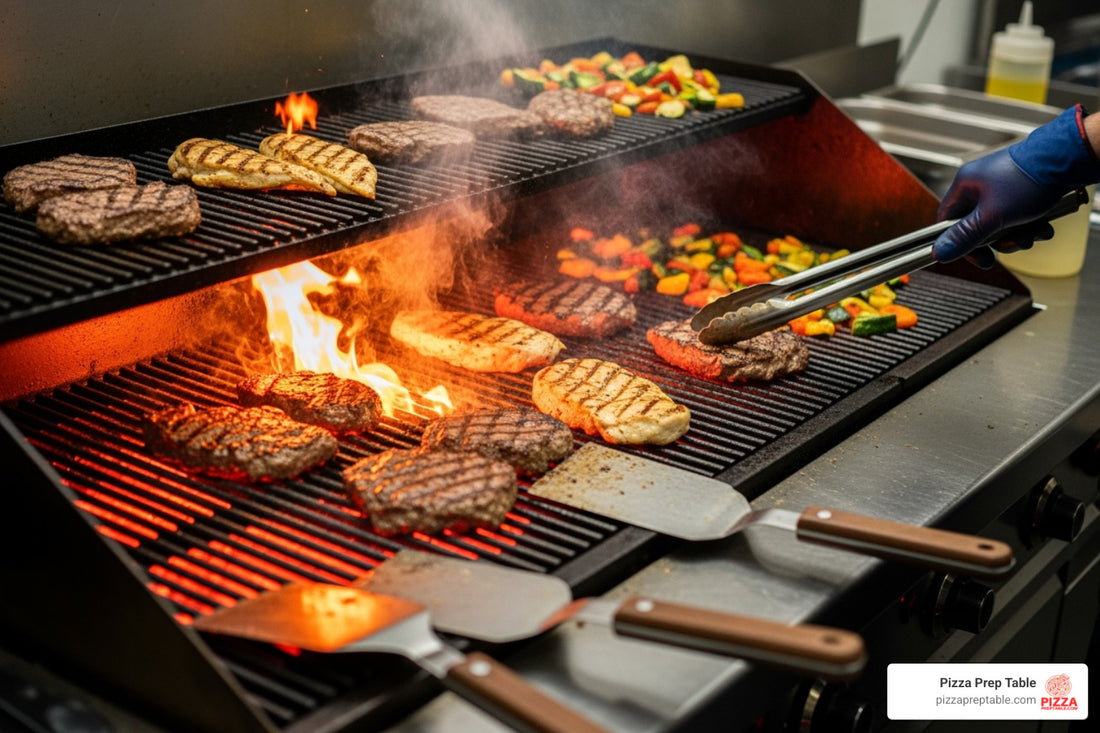
Infrared vs. Wood-Fired: Which Charbroiler Reigns Supreme?
Share
The Sizzle Showdown: Choosing Your Kitchen's Champion
An infrared charbroiler grill uses radiant heat technology to cook food faster and more evenly than traditional grilling methods. Here's what makes infrared charbroilers stand out:
Key Benefits:
- 50% less gas consumption compared to standard charbroilers
- 30% more moisture retention in grilled foods
- Prevents flare-ups through heat deflector panels
- Even heat distribution eliminates hot and cold spots
- Faster preheating and consistent cooking temperatures
Best For: Steaks, chicken, fish, and vegetables requiring precise temperature control and professional searing capabilities.
When you're setting up your first restaurant kitchen, choosing the right charbroiler can make or break your operation. The battle between infrared precision and wood-fired tradition has been heating up commercial kitchens for years.
Infrared charbroilers promise energy savings and consistent results. Wood-fired grills deliver that smoky flavor customers crave. But which one fits your budget, space, and menu goals?
The stakes are high. Pick wrong, and you'll face higher energy bills, inconsistent food quality, or unhappy customers. Pick right, and you'll have a kitchen champion that boosts profits and builds your reputation.
I'm Sean Kearney, and my experience selling restaurant equipment has shown me how the right infrared charbroiler grill can transform a struggling kitchen into a profit machine. From helping small cafes maximize their limited space to guiding restaurant chains through major equipment purchases, I've seen which grilling technologies deliver real results.
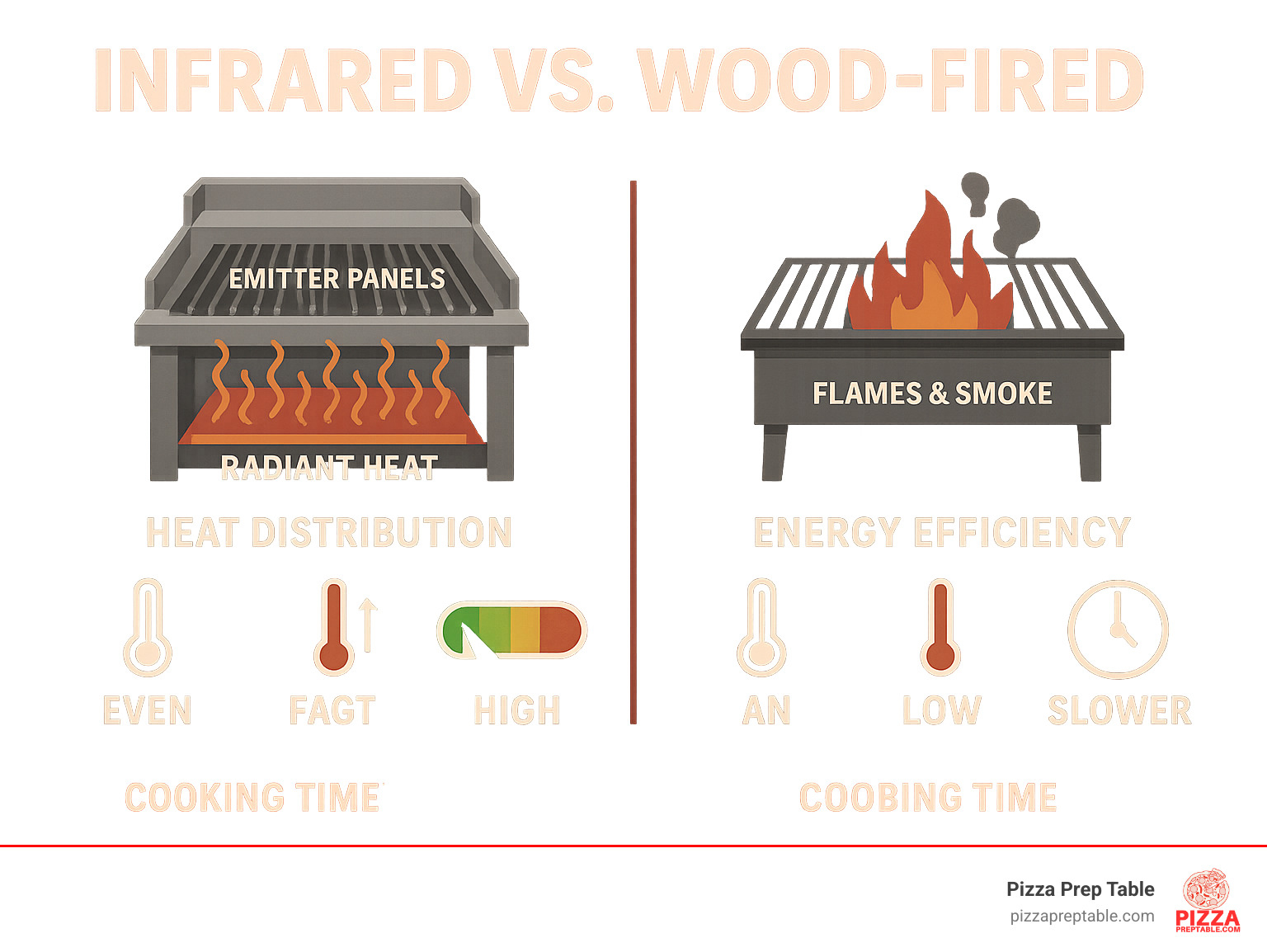
The Power and Precision of the Infrared Charbroiler Grill
Picture this: you're grilling a perfect steak, and instead of wrestling with hot spots and flare-ups, you get restaurant-quality results every single time. That's the magic of an infrared charbroiler grill.
Traditional gas grills cook your food through convection (hot air swirling around) and conduction (direct contact with hot grates). It's like trying to cook with a hair dryer and a hot pan at the same time - not exactly precise.
An infrared charbroiler grill works completely differently. Think of how the sun warms your face on a cold day - that's radiant heat in action. These grills use specialized emitter panels that convert gas flames into intense infrared radiation. This energy beams directly into your food, bypassing all that moisture-stealing hot air. For a quick primer on the science and method, see infrared grill.
The result? Your grill reaches higher temperatures faster while actually using less gas. It's like having a miniature sun working for your kitchen, delivering concentrated heat exactly where you need it.
Modern systems like Vulcan's IRX technology and Char-Broil's TRU-Infrared system have perfected this approach. They create an intense, even cooking surface that transforms how commercial kitchens operate.
More info about char broilers.
How an infrared charbroiler grill improves food quality
Here's where things get delicious. Every chef knows the secret to great grilling: keep the juices in, get the flavor out. An infrared charbroiler grill nails this better than any other cooking method.
The biggest game-changer is moisture retention. Traditional grills blow hot air around your food, literally sucking the juices right out. Infrared cooking eliminates most of that air circulation, allowing food to retain up to 30% more of its natural moisture. Your steaks stay juicy, your chicken doesn't dry out, and your customers notice the difference immediately.
Searing capability reaches a whole new level with infrared heat. That intense, direct energy creates the perfect crust while locking juices inside. You'll get those beautiful diamond grill marks and rich, complex flavors from the Maillard reaction every single time.
But here's what really sets infrared apart: no hot or cold spots. We've all played the grill shuffle, moving food around to find the sweet spots. With an infrared charbroiler grill, the emitter panel spreads heat uniformly across the entire cooking surface. Every piece of food cooks evenly, giving you consistent results that build customer loyalty.
Key benefits for the modern commercial kitchen
Let's talk about what really matters in a busy kitchen: efficiency, safety, and profit margins.
Energy savings top the list. An infrared charbroiler grill uses up to 50% less gas than traditional charbroilers. In a restaurant running 12+ hours daily, those savings add up fast. You're getting higher temperatures with lower BTU output - it's like getting more power while paying less for fuel.
Flare-up prevention makes your kitchen safer and your food more consistent. Those scary flame bursts happen when grease hits open burners. Infrared systems use emitter panels as shields, keeping grease away from flames. Your insurance company will love you, and your food won't get accidentally charred.
Increased production capacity means serving more customers faster. Food cooks quicker and more predictably, so you can turn tables faster. No more babysitting hot spots or repositioning food - just consistent, efficient cooking.
Faster cleanup sounds too good to be true, but it's real. Many infrared systems feature full-width stainless steel crumb trays for easy debris collection. The emitter panels actually turn most debris into ash, which wipes away easily. Less scrubbing means more time for what matters: cooking great food.
The Timeless Allure of Wood-Fired Grilling
While the infrared charbroiler grill represents the cutting edge of cooking technology, there's a timeless appeal to the traditional, primal art of wood-fired grilling. This method taps into something deeply satisfying, both for the chef and for the customer.
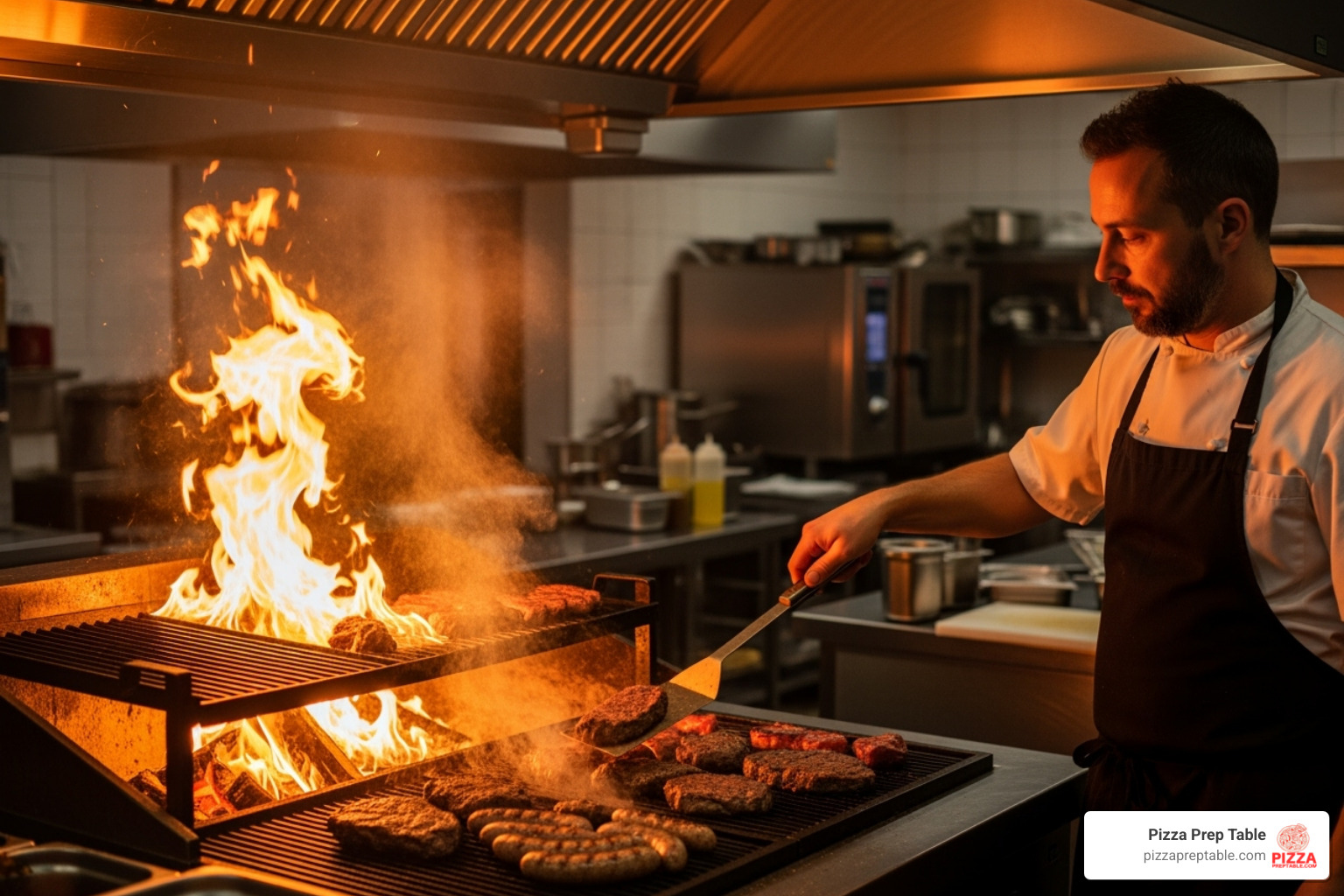
Wood-fired grilling, often seen in authentic pizzerias, steakhouses, and rustic eateries, uses actual wood (or sometimes charcoal, which derives from wood) as its primary fuel source. This isn't about precise temperature control via knobs; it's about mastering the flame, understanding the nuances of different wood types, and letting the raw power of fire transform food.
The allure often comes down to two things: authentic flavor and the customer experience. There's nothing quite like the smoky aroma that emanates from a wood-fired grill, hinting at the culinary delights to come. Customers are often fascinated by the visible flames and the chef's skill in managing them. It adds a theatrical element to the dining experience, a connection to ancient cooking traditions. This method is known for giving appealing markings and unmatchable flavor profiles to a variety of menu items, bringing the distinct flavor and appearance of an outside grill to life in an indoor kitchen.
What gives wood-fired food its signature taste?
The magic of wood-fired food lies in the interaction between the ingredients and the combustion of the wood. It's not just about heat; it's about the smoke. As wood burns, it releases compounds that infuse the food, creating a complex, earthy, and often sweet or savory flavor profile that's impossible to replicate with gas alone. This is where the Maillard reaction and caramelization truly shine, improved by the unique contributions of wood smoke.
Different types of wood impart distinct flavors. Oak might give a strong, smoky taste, while fruitwoods like apple or cherry offer a milder, sweeter note. Mesquite is bold and earthy, perfect for beef. The chef's choice of wood becomes another ingredient, adding depth and character to the dish.
While some modern infrared grills (like the Kosei Charcoal Griller mentioned in our research) claim to get close to a charcoal-like taste, and even allow for a small amount of natural charcoal to be used alongside gas, the true wood-fired experience is about the entire process. The high heat from burning wood sears the food quickly, locking in juices, while the smoky essence penetrates deeply, creating a truly unique culinary signature.
Fueling the Fire: Choosing Between Char Broiler, Gas, and Charcoal.
Operational considerations of wood-fired grills
While the flavor of wood-fired cooking is undeniably appealing, it comes with its own set of operational challenges that we need to consider for a commercial kitchen.
First, fuel costs and sourcing. Unlike gas, which is piped in, wood needs to be purchased, stored, and constantly replenished. The quality and type of wood matter, affecting both cost and flavor. Storage requires significant space, and the wood needs to be kept dry.
Heat-up time and temperature management are also more demanding. A wood-fired grill takes longer to reach optimal cooking temperatures compared to an instant-on gas or electric unit. Once hot, maintaining consistent temperatures requires skill and constant attention. It's not a set-it-and-forget-it system; chefs need to manage the fire, adding wood, adjusting airflow, and understanding how heat radiates from the embers. This means more staff training and a higher level of expertise are required.
Cleaning and maintenance are also more intensive. Wood-fired grills produce ash, and a lot of it. This ash needs to be regularly removed, and the grill surfaces require thorough cleaning. The internal components can also accumulate creosote and other residues, necessitating more frequent and specialized cleaning procedures to ensure safety and performance.
Finally, ventilation requirements are paramount. Burning wood produces significant smoke and particulate matter. Proper, robust ventilation systems are absolutely essential to safely extract these byproducts from the kitchen, ensuring a healthy environment for staff and customers, and complying with local fire and health codes. This often means a higher upfront investment in HVAC.
Head-to-Head: A Culinary Comparison
Now for the main event: a direct comparison between the precision of an infrared charbroiler grill and the rustic charm of wood-fired grilling. Which one truly reigns supreme for your commercial kitchen?
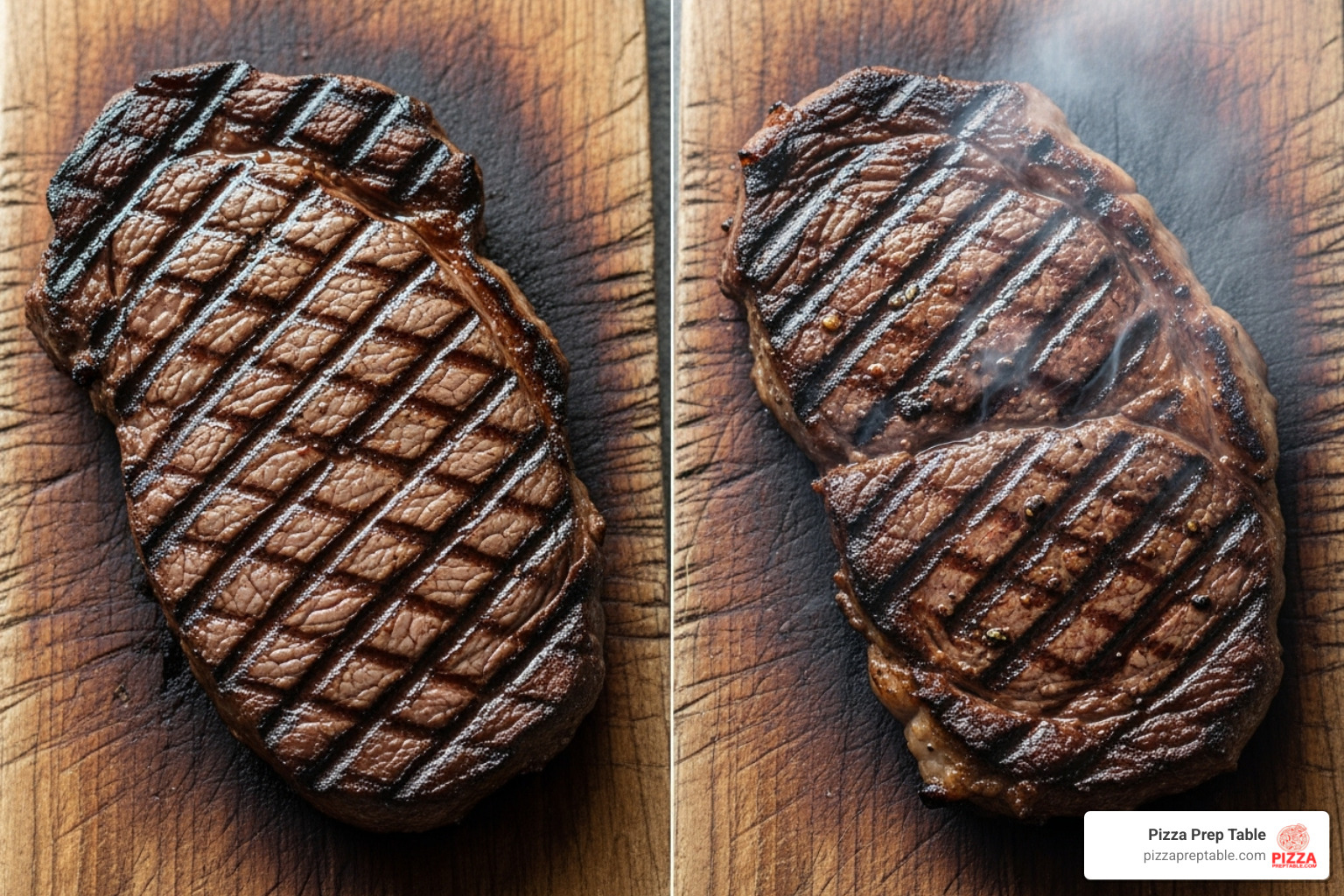
| Feature | Infrared Charbroiler Grill | Wood-Fired Grill |
|---|---|---|
| Heat-Up Time | Fast (minutes), consistent | Slow (30+ minutes), variable |
| Temperature Consistency | Excellent, even heat, no hot/cold spots | Variable, requires skilled management |
| Flavor Profile | Clean, intense sear, juicy, natural food flavor | Smoky, earthy, distinct wood notes, primal |
| Flare-Ups | Virtually eliminated by emitter panel | Common, requires constant attention |
| Energy Efficiency | High (up to 50% less gas), lower BTU for high heat | Lower, fuel constantly consumed, heat loss |
| Upfront Cost | Moderate to High (depending on size/features) | Moderate to High (plus significant ventilation system) |
| Maintenance | Easier (crumb tray, wipe down, emitter panel checks) | More intensive (ash removal, creosote cleaning, wood storage) |
What foods cook best on each type?
Choosing the right charbroiler often comes down to your menu and the specific cooking results you want to achieve.
For an infrared charbroiler grill, we recommend:
- Steaks: For that perfect, restaurant-quality sear and juicy interior.
- Chicken: Especially breasts and thighs, for even cooking and moisture retention.
- Delicate Fish: The even heat prevents sticking and flaking, ensuring a beautiful finish.
- Vegetables: For vibrant colors, a slight char, and retaining their natural crispness. Think asparagus, bell peppers, or even charred cabbage with a smoky crunch.
- Kabobs: For uniform cooking of multiple ingredients.
The precision and consistent heat of infrared are ideal for items where even cooking, a strong sear, and maximum juiciness are paramount.
For wood-fired grills, the focus shifts to dishes that benefit from deep smoky flavors and rustic charm:
- Burgers: A classic for wood-fired, absorbing that smoky essence.
- Ribs: Slow-cooked and finished on the grill for a tender, smoky bite.
- Whole Chickens: The longer cooking time allows for deep smoke penetration.
- Rustic Vegetables: Such as corn on the cob, large root vegetables, or hearty greens that can stand up to intense heat and smoke.
- Thick Cuts of Meat: Where a strong smoky crust is desired.
Wood-fired cooking is about infusing flavor and creating a distinct, traditional experience.
Cost and Value: Is an infrared charbroiler grill a good investment?
When considering the cost, look beyond the initial purchase price and evaluate the long-term value proposition.
The upfront cost of an infrared charbroiler grill can be comparable to or slightly higher than traditional gas charbroilers, with prices ranging from around $4,700 to over $21,000 for commercial units, depending on size and features. For instance, a 60-inch wide infrared charbroiler grill might be around $14,600, while a 25-inch unit could be closer to $7,000. Wood-fired grills can also vary widely, but often require significant additional investment in robust ventilation systems, which can push the total installation cost higher.
However, the long-term value of an infrared charbroiler grill truly shines.
- Energy Savings: As we've seen, consuming up to 50% less gas means substantial operational savings over the lifespan of the unit. This can quickly offset any higher initial cost.
- Reduced Food Waste: By retaining up to 30% more moisture, you're getting more yield from your ingredients, leading to less waste and better portion control. This directly impacts your food cost percentages.
- Labor Costs: Faster cooking times and easier cleaning can reduce labor hours spent on grilling and maintenance, freeing up staff for other tasks.
- Productivity & Profitability: Increased production capacity means you can serve more customers in less time, directly boosting your revenue.
For us at Pizza Prep Table, we understand that smart investments lead to long-term success. An infrared charbroiler grill isn't just an expense; it's an investment in efficiency, food quality, and ultimately, your restaurant's profitability.
Learn about restaurant financing options.
Making the Right Choice for Your Restaurant
Choosing between an infrared charbroiler grill and a wood-fired grill isn't just about picking equipment – it's about matching your cooking style with your business reality. After years of helping restaurant owners make this decision, I've learned that the best choice depends on three key factors: your space, your concept, and your volume.
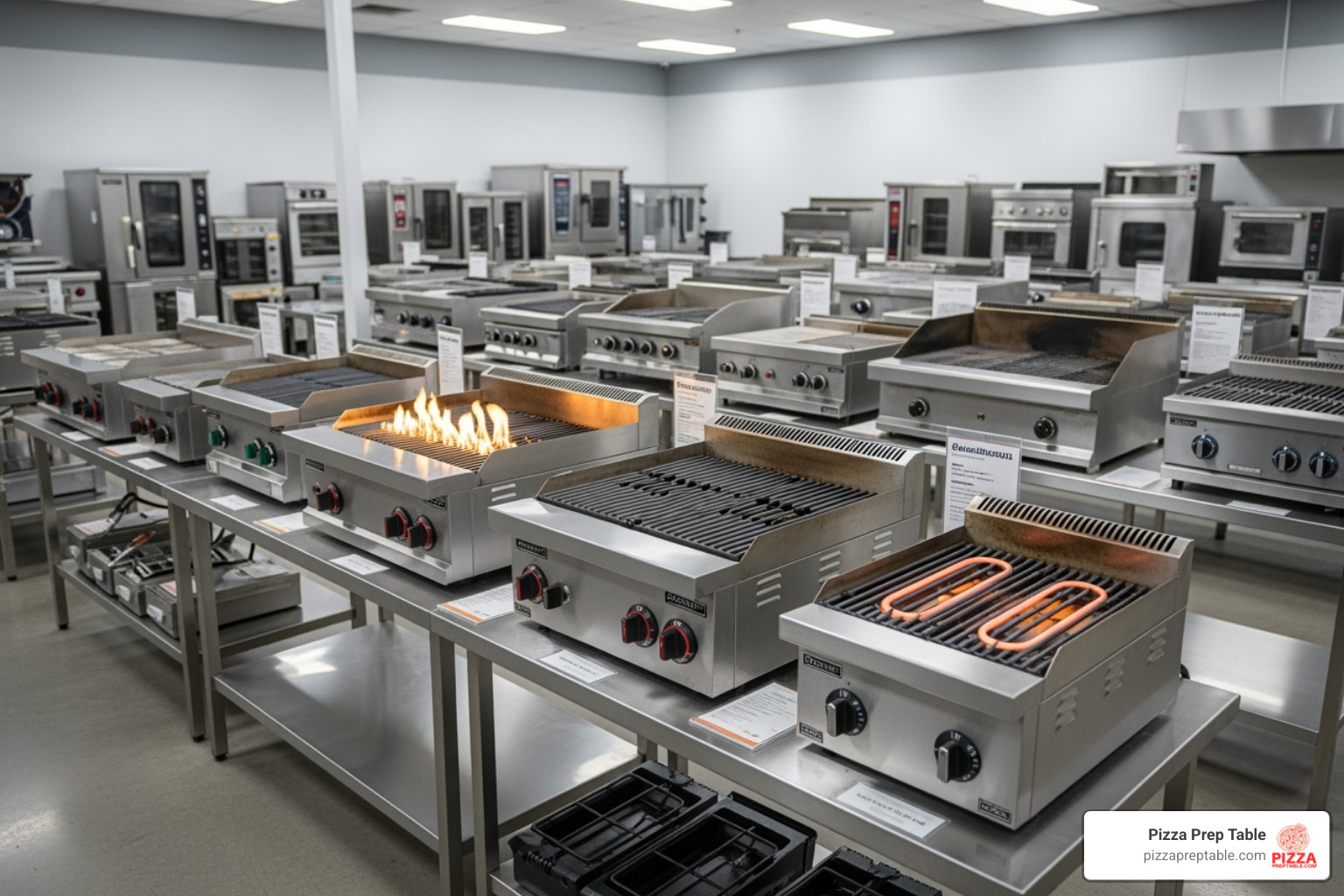
Let's start with kitchen space, because this often makes the decision for you. Wood-fired grills are space hogs. You need room for the grill itself, wood storage (and trust me, you'll need more storage than you think), plus heavy-duty ventilation that can handle serious smoke output. An infrared charbroiler grill plays nice with smaller spaces – it gives you professional results without demanding half your kitchen.
Your menu concept tells the real story though. Are you building a rustic steakhouse where customers expect to see flames and smell wood smoke? That theatrical element of wood-fired cooking becomes part of your brand. But if you're running a busy bistro where consistency and speed matter more than showmanship, infrared precision wins every time.
Production volume is where the rubber meets the road. During a dinner rush, you need equipment that keeps up without babysitting. Wood-fired grills cook amazing food, but they need constant attention – adjusting airflow, managing coals, working around hot spots. An infrared charbroiler grill heats up fast, stays consistent, and lets your cooks focus on plating instead of fire management.
Don't forget about your budget – and I mean the real budget, not just the sticker price. Wood-fired setups often need expensive ventilation upgrades that can double your installation costs. Factor in ongoing fuel costs, extra labor for maintenance, and the learning curve for staff training.
Grill Small, Eat Big: Top Compact Char Broiler Picks.
Key features to look for in a commercial charbroiler
When you're ready to buy, focus on features that'll make your life easier and your food better. The BTU output matters, but it's not everything. Commercial units range from 22,000 BTU for compact models up to 160,000 BTU for large operations. With infrared technology, you get high heat from lower BTU ratings – it's about efficiency, not just raw power.
Construction materials separate the good from the great. Heavy-gauge stainless steel construction means your charbroiler will survive the daily beating of commercial service. Cheap materials look fine in the showroom but crack under pressure (literally).
The grate design affects every piece of food you serve. Porcelain-coated cast iron grates hold heat beautifully and resist rust. On infrared charbroiler grills, look for patented grate designs that work with the emitter panels to prevent flare-ups – your cooks will thank you during busy nights.
Size and dimensions need to match your reality, not your dreams. A 72-inch monster looks impressive, but if it doesn't fit your space or volume, you've wasted money. Compact 14-inch countertop models work great for small operations, while 36-inch units hit the sweet spot for most restaurants.
Most commercial charbroilers run on gas (natural gas or propane), though electric models exist. Your existing utility setup usually makes this choice for you. Infrared charbroiler grills are predominantly gas-powered – they convert that gas heat into radiant energy that cooks food faster and more evenly.
Ease of cleaning saves money every single day. Look for full-width crumb trays, sealed burner pans, and removable components. Features like easily accessible emitter panels or grates that pop out for washing make the end-of-shift cleanup bearable instead of brutal.
Maintenance and longevity
Good maintenance habits turn expensive equipment into profitable investments. With an infrared charbroiler grill, daily cleaning stays simple – wipe surfaces, empty the crumb tray, clean the grates. The emitter panels need regular attention, but debris usually turns to ash that brushes away easily.
Some operators report the top mesh on infrared burners wearing out after about a year of heavy use. This is normal wear for consumable parts, so understand your warranty coverage. Most commercial units come with one-year parts and labor warranties, but read the fine print on consumable components.
Wood-fired grills demand more hands-on maintenance. Ash removal becomes a daily ritual to maintain proper airflow. The grill surfaces and internal components need frequent scraping to remove carbon and creosote buildup. It's labor-intensive but essential for safety and performance.
Regular maintenance prevents expensive breakdowns and keeps food quality consistent. A well-maintained charbroiler lasts years longer than one that's ignored. Always follow the manufacturer's maintenance schedule – those guidelines exist because equipment fails predictably when neglected.
The bottom line? Whether you choose infrared precision or wood-fired tradition, commit to proper care. Your equipment investment should serve you profitably for years, not months.
Conclusion: The Final Verdict for Your Kitchen
After diving deep into this grilling showdown, here's the truth: there's no universal winner between the infrared charbroiler grill and wood-fired grilling. The real champion is the one that fits your restaurant like a perfectly custom chef's coat.
Think of it this way - choosing your grill is like choosing your signature dish. It needs to match your style, your customers' expectations, and your kitchen's capabilities.
The infrared charbroiler grill emerges as the clear winner when your priorities are precision cooking, energy savings, and consistent results. If you're running a high-volume operation where every minute counts, or if your menu features delicate proteins that need perfect temperature control, infrared technology delivers. The 50% gas savings alone can transform your monthly operating costs, while the moisture retention keeps customers coming back for those perfectly juicy steaks.
Wood-fired grilling takes the crown when your brand story revolves around authentic, smoky flavors and that primal cooking experience. If your customers choose you for that unmistakable wood-smoke taste, or if watching flames dance is part of your restaurant's theater, then the operational complexities become worthwhile investments in your unique identity.
Your business needs should drive this decision, not trends or what the restaurant down the street is using. Consider your menu goals - are you aiming for precision or authenticity? Think about your kitchen space, your staff's skill level, and honestly assess your budget for both upfront costs and ongoing operations.
At Pizza Prep Table, we've helped countless restaurant owners steer these exact decisions. Whether you're a small pizzeria in Chicago looking to add grilling to your menu, or a growing chain in Los Angeles seeking consistent results across multiple locations, we understand that the right equipment can make or break your success.
We're not just here to sell you equipment - we're here to help you build a profitable kitchen. That's why we offer financing options that work for both independent shops and larger establishments, making it easier to invest in the technology that truly serves your vision.
Ready to find your kitchen's champion? Let's talk about which grilling solution fits your restaurant's unique recipe for success.
